
With its straightforward and detailed teaching resources, helpful tools and charts, incremental approach to writing, and a strong foundation in classical education, Lost Tools of Writing can be an excellent resource for homeschools that can provide students with a reliable framework for producing high quality, persuasive and logical writing.
What We Like
But watch out for…
What Are The Lost Tools Of Writing?
Created by Andrew Kern and Leah Lutz, the Lost Tools of Writing is a classically-inspired homeschool writing curriculum aimed at students in middle and high school.
The program aims to teach students to create logical arguments and to write more clearly and effectively, doing so through a combination of video instruction, incremental lessons, guided discussions, an assortment of worksheets and tools and, of course, an assortment of writing exercises.
What Ages Or Grades Is Lost Tools Of Writing Intended For?
For the most part, Lost Tools of Writing is roughly aimed at students in grades 7-12, or roughly those 12 and up.
This is due to the fact that Lost Tools of Writing is not an introductory course in Language Arts but is instead specifically designed to help students hone more advanced composition skills.
The curriculum essentially starts off with basic persuasive essay writing and slowly progresses from there, working on skills and topics such as structure and organization, identifying and constructing effective arguments, compound sentences, and the effective deployment of tropes and tools such as parallelisms, personification, similes, and so on.
As such, the program presupposes that its students already have a firm understanding of the fundamentals of grammar and mechanics, such as verb tenses, sentence and paragraph structure, the eighth parts of speech (nouns, pronouns, verbs, adjectives, adverbs, prepositions, conjunctions, interjections) and so on.
It also assumes that a student has some ability in reading, comprehension and forming simple arguments.
With all that said, The Lost Tools of Writing is really a skill-based program, rather than a grade- or age-linked curriculum.
The program is divided into three levels, and while Level 1 requires that students are somewhat firm on the fundamental skills mentioned above, Levels 2 and 3 really only require students to have completed the previous levels.
Consequently, Lost Tools of Writing can feasibly be started and used by homeschooling students outside of its intended age range, be they precocious and skilled ELA learners in upper elementary or high-schoolers who need a bit of remedial help, so long as they are firm on essential grammar and sentence structure.
What’s Required To Teach The Lost Tools Of Writing?
The Lost Tools of Writing is a pretty comprehensive program, and each of its three levels include a teaching guide, student book, online videos and even online classes that parents can sign their students up for.
Teacher’s Guide
The teacher’s guide for Lost Tools of Writing is a spiral bound, ~350-400 page black and white softcover book that contains most of what’s needed to teach the program’s lessons.
The guides contain key information that parents will need, such as an introduction and explanation of the program’s methodology and approach, definitions and explanations of key concepts, assessments, charts, summaries and more.
They also contain lesson plans and outlines, which lay out the explanations for each writing tool or aid (such as the ANI charts), offer a variety of helpful teaching tips, contain step-by-step instructions for carrying out a lesson, instructions for reviewing and helping students practice certain skills and, of course, the essay topics themselves.
Fior the most part, Lost Tools of Writing teacher’s guides are pretty easy to use and moderately scripted.
They generally provide a good deal of detailed, clear, sequential and easy to follow lesson instructions, particularly when it comes to explaining the various tools and processes that students will be expected to use, which is always very helpful.
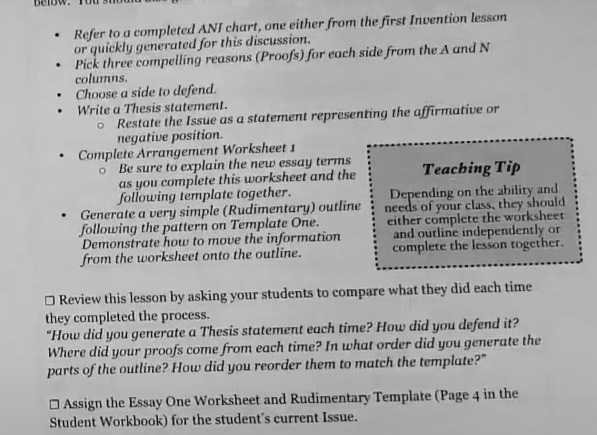
That said, although the guides provide a good number of specific examples, they don’t always provide explicit word-for-word dialogues for parents to simply read aloud, often relying on a parent’s ability to naturally interact and dialogue with their student.
While this does make the program easier to adapt to different teaching styles and student preferences, something that more experienced homeschoolers and those who are secure in their ability to teach Language Arts will appreciate, it does mean that those new to homeschooling may need to take a little more time to think about how best to specifically introduce and discuss topics before a lesson.
In terms of their overall look and feel, the teacher’s guides are quite focused on teaching writing.
As a result, the guides are mainly textual and don’t conclude any color or illustrations beyond the many charts and diagrams used during lessons.
On the one hand, this means that they aren’t the most fascinating to look at for extended periods, but on the other they are very informative, focused and distraction-free.
Interestingly, Lost Tools of Writing also offers a Handbook of Types to go along with its Level 1 Parent’s guide.
Using various classic texts (Cinderella, the Wind in the Willows, Julius Cesar), the book provides a variety of examples of the content taught in the course for all stages of the classical rhetoric writing approach, with several examples of filled out worksheets for invention, arrangement, elocution, including the use of ANI charts, proper outlining and even essays.

Having filled out examples can help parents better understand the Lost Tools process a little better and gives parents a ready example of what the end result of each lesson should look like, which is always helpful if they and their students suddenly draw a blank.
Student Workbook
The student workbooks are where students will spend most of their time when working on their writing.
They are somewhat similar in style to the parent’s guide, being consumable spiral-bound softcover books.
They contain the various charts and tools that can help students organize their writing, various exercises, guiding questions to help students construct and fill out their essays, sample outlines, examples.
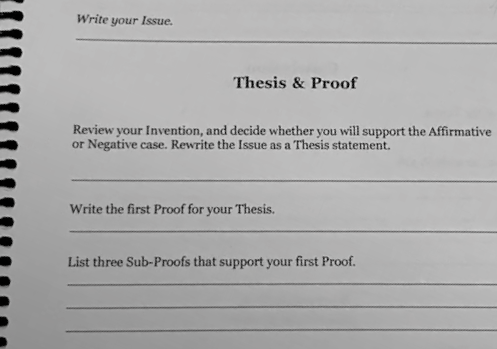
At times there are even focused exercises for the writing skills and concepts they are introduced to during lessons, which can act as good practice to build skill fluency.

At times, the student workbooks also provide quick examples, tips and explanations of concepts and tools that can help guide them and refresh their memories, such as a half page or so on how to build stronger sentences through the use of precise verbs, which is always helpful.
It should be noted, however, that Lost Tools of Writing isn’t a self-study program and the student workbooks really need to be used alongside the teaching guide and other resources, which provide the required level of conceptual instruction, guided practice and detail.
Overall, the workbooks are laid out quite sequentially, are fairly straightforward and, by and large, students are pretty unlikely to get lost when they go off and work on their assignments on their own.
Like the teacher’s guides the student workbooks are mainly text-based.
With no real color or illustration, they aren’t intrinsically the most interesting for students to look at.
This is perhaps less of a concern for middle and high school students than it might be for younger elementary school students, but it is something that parents should note.
That said, the lack of pictures and drawings really keeps the workbooks focused on the learning itself and can be a lot less distracting on the whole compared to some other program materials, which is something that certain students can really benefit from.
Lost Tools of Writing Videos
The Lost Tools of Writing also offers homeschooling families a series of streaming instructional videos to be used alongside the teacher’s guides.
The videos are hosted by the creators of the program (Andrew Kern and Leah Lutz) who go through the program’s particular methodology and techniques, as well as explaining and demonstrating the various topics and tools the program touches on or uses, as can be seen in the video example below.
These videos are intended to complement Lost Tools of Writing’s teacher’s guides, providing parents with helpful ELA instruction and tips and generally guiding them through the program’s process as it relates to teaching.
This makes them particularly useful for parents who are unfamiliar with a classical approach to writing instruction, as well as those who are themselves a bit rusty on their upper-level ELA and writing skills.
By and large, the videos are very professionally presented.
Kern and Lutz do a good job at explaining concepts in a clear and straightforward way, often using a whiteboard to help organize and visualize the concepts they touch on and even pausing to give parents an opportunity to think or try things for themselves, which is always appreciated.
For the most part, the program’s videos correspond to the lessons included in each level, with the exception of a few instances where skills are presented over several videos or are combined into one topic, which means that they are very easy to weave into a week’s teaching plan.
In fact, we feel that the videos can even be used as a resource by older high school students as well should they need a more in-depth review about a point or need some clarification regarding a particular approach or tool’s use.
It should be noted that, although they keep things concise and to the point, the videos are pretty simple and don’t really have a lot of in the way of effects or excitement – they are pretty focused on teaching writing..
The videos are, however, fairly short and easy to watch, being only around 7-20 minutes long, which means that they aren’t that hard to sit through or difficult to pencil into even a busy parenting schedule, which is always nice.
Online Classes
Interestingly, the company behind Lost Tools of Writing, the Circe Institute, also runs live online classes for the program.
The classes are full, mastery-style courses that cover the different levels of Lost Tools of Writing, as well as a number of other specialty subjects, such as Latin, Philosophy, History and so on.
These classes are done online through a combination of Zoom, email and the Canvas Course Management System, being taught live at particular times of the day (daytime Easter Standard Time hours) in a small class setting with a maximum of 14 students.
Each course is led by experienced teachers, who conduct their lessons through a Socratic question and answer style back and forth dialogue and mimetic teaching.
Students then submit their work and assignments through email, which are personally graded by the course teacher.
Parents receive a final assessment at the end of the course, which can then be used for credit on a student transcript.
While we weren’t able to try the online courses ourselves, we do see how they can be beneficial, particularly for busier parents who don’t have the time to teach Lost Tools themselves, students who do well in a more structured and formal learning environment and those who simply enjoy interacting and brainstorming with other students.
Parents should note that many of Lost Tools of Writing courses make use of specific titles in classic literature (such as the Hobbit, the Lord of the Rings, Dostoyevski, various short story and poetry compilations and so on).
These are often used as examples for writing and literary discussions, which is always nice to see, but does mean that parents will have to source additional materials.
It should also be noted that the online courses aren’t the cheapest we’ve seen, with a full year’s course running around $647, a 15 week semester costing around $322 and 8 week intensives running between $322 and $500, in addition to a $75 registration fee.
The Lost Tools of Writing Approach To Teaching Writing
Classically Inspired
Lost Tools of Writing is a writing program that is rooted in the principles of classical education and rhetoric.
The program breaks writing down into an orderly process and largely centers around three Canons of Rhetoric, which it identifies as a potential solution to common issues students face when writing.
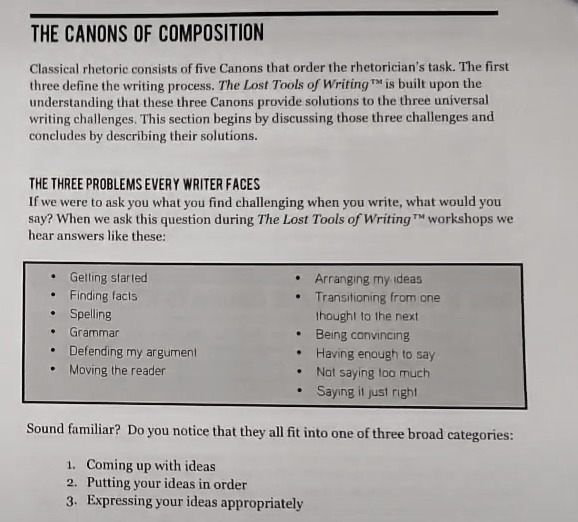
These canons are:
- Invention, i.e. where students gather their thoughts and figure out what to write about
- Arrangement, i.e. how to organize, research,outline and structure writing in a logical way
- Elocution, i.e. how to express these ideas in the most persuasive and logical way possible
These canons of writing largely form the core of the program’s lesson progression, with students moving working on each canon sequentially to produce a written work.
(It should be noted that there are actually 5 Canons of Rhetoric in a Classical Educational model, but the final two (Memoria and Delivery) are centered on conveying and presenting written work orally.
Keeping things centered on the first three canons, however, does make sense for a writing program such as Lost Tools.)
Lost Tools of Writing’s written exercises, too, are heavily inspired by classical rhetoric and, aside from learning how to properly brainstorm, organize, write and even justify persuasive and comparative essays, students are also given the opportunity to try their hand at judicial and deliberative rhetoric through addresses.
The addition of these addresses in Levels 2 and 3, which are forms of writing aimed at decision makers and which are usually written in the first or second person, sets Lost Tools of Writing apart from most other homeschool writing programs that we’ve seen.
These judicial and deliberative addresses help students learn to analyze an audience, establish and distill facts, analyze a situation, defend their position and can generally help students develop very powerful logical, organizational and critical writing skills that can be applied to just about any academic writing that they may come across.
Parents should note, however, that this focus on rhetoric may not be for every homeschool and there may not be quite the diversity of writing exercises and styles that might be seen in other programs, such as diaries, free-writing, poetry, short stories and on.
Structured Writing
The Lost Tools of Writing program teaches its writing skills in a very structured, organized manner.
As mentioned, in the program writing is taught as a specific process that students follow.
From ideation through elocution and, ultimately, editing and refinement, students learn to approach written work in a logical, ordered way and are given the tools and knowledge (thesis-development, idea generation, outlining, specific writing skills, etc) that they can fall back on and use for just about any writing assignment they may come across, whether that’s the essays and addresses contained in the program or whether it is ACT/SAT essays or academic writing later in their careers.
Further, and similar to programs such as IEW, the program provides a number of organizational tools, worksheets and guides that students can use to help learn to structure their thinking and writing process, such as ANI Charts and short guiding worksheets.
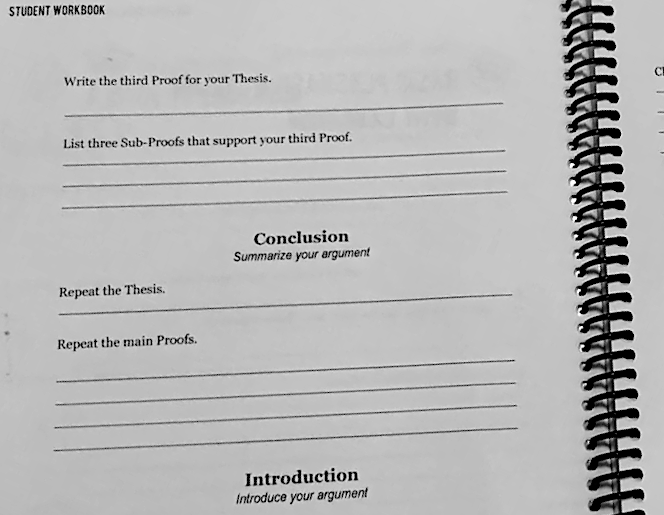
In general, teaching a systematic approach to writing can be very effective, as having a particular methodology to follow can help students better deal with writing prompts, preventing them from blanking out or chaotically jotting down their thoughts.
A structured, step-by-step approach can be particularly useful for reluctant writers and those who tend to see writing as a stressful, mystifying process.
Sequential and Incremental Lessons
Lost Tools of Writing also teaches through a step-by-step, incremental process.
By and large, the tools, tropes and concepts of rhetoric are broken down and introduced gradually, allowing students to get used to and master them one at a time before building on these skills.
This incremental approach carries over to the program’s written work, as well, with students first planning, organizing and then ultimately writing work before adding, refining and expanding their abilities in later assignments and during subsequent lessons.
For example, during the process of writing an essay in Level 1, students might first spend a lesson generating a thesis from a piece of literature (the Hobbit or the Lion the Witch and the Wardrobe, for instance, although parents are free to substitute pretty much any titles or really any subject they’d like) and generate an assortment of ideas that afford or negate that thesis.
The next lesson would have them use an ANI chart to sort and group those ideas in preparation for creating an outline that they would transcribe into their student book.
Finally, students would learn and then make use of various skills (similes, assonance, alliteration, compound sentences) to expand their outline into a rudimentary essay.
After creating their first essay, and as lessons go on and students learn more skills, the program would then have them gradually refine their skills and produce higher quality, more complex written work.
This step by step, incremental approach even continues through the different levels of the program, with the topics and written works of Level 2 (judicial address) building on the skills and tools developed in Level 1 (the persuasive essay), and Level 3 (deliberative address) building on those of Level 2.

In this way, Lost Tools of Writing can make the process of writing more manageable and can get students to grapple and master more complex ideas and writing skills without overloading them quite as much.
That said, at times the process can sometimes feel a bit slow and too gradual for some students, at least in terms of overall progression, particularly for those who tend to want to jump into writing and express themselves ASAP.
Parent-led, guided instruction
Although students do spend a fair amount of time working on their writing and filling out worksheets as assignments, Lost Tools of Writing is not itself a self-study program and requires a fair bit of parent-student interaction.
Lessons in Lost Tools often include a lot of back and forth dialogue and discussion between parent and student, especially when it comes to ideation, introducing new concepts and tools and review.
For example, there is often a good deal of discussion aimed at drawing out a student’s ideas, often through the use of Socratic-style guided questions, probing a student’s understanding of specific topics and getting them to come to a conclusion in a sort of step-by-step and guided manner.

Further, during lessons parents are often encouraged to help their student reflect on their ideas, justify their choices or expand on a topic, which can lead to some interesting conversations to say the least.
Lessons may also, at times, involve modeling, where parents and students select a well-written piece of writing in order to examine their particular structures, themes and even tropes.
Parents might then be asked to demonstrate how to analyze, recreate or derive certain writing skills or topics from a text before having a student try their hand at it, ultimately helping students grasp abstract concepts through concrete examples.
The high degree of interaction between parent and student in Lost Tools of Writing can be a great way to encourage reluctant students to open up and engage in the writing process, especially when it draws out and allows them to express their personal thoughts and ideas and gives them the freedom to generate their own thesis.
It can also be quite enjoyable, particularly for parents who got into homeschooling for the greater personal interaction and quality time that it can afford them with their children.
Further, the Socratic-style back and forth can really yield some fascinating insights into the thoughts, opinions and ideas of a developing child, which can be very cool for parents to see.
On the downside, it does mean that the program can be somewhat time intensive for parents, as lessons can take time to prepare and go through, particularly if and when students get really into the discussions and want to explore their thoughts more deeply.
This can be something of an issue for some time-poor households who may instead want to consider the program’s professionally taught online classes.
How It Works
Each level in Lost Tools of Writing is designed to take about a year to complete at a 4 lesson per week pace, containing about 28 weeks worth of instruction, although there is considerable leeway and parents can easily spread the program out across two years should a student need.
Each course is essentially centered around a cycle of sorts, with 8 essays (or addresses) that somewhat act as units of study.
Each of these units is split into three or four individual lessons, which carry students through each of the three canons of writing (Invention, Arrangement and Elocution) in a step-by-step manner until their composition has been completed.
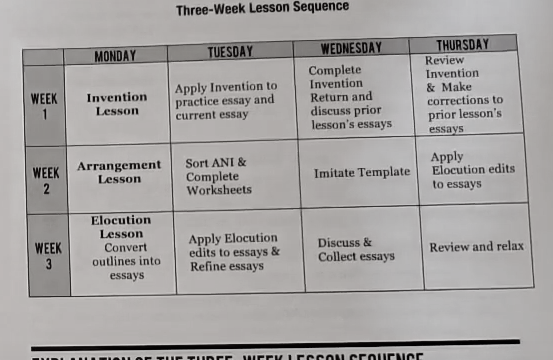
Each individual lesson is designed to take about a week to complete, which means that students end up creating a writing sample over three weeks before repeating the process and creating a new piece of writing that integrates new writing skills and knowledge, thereby incrementally creating more complex and sophisticated compositions.
To see how this works in practice, we can examine how the lessons might progress to create a persuasive essay.
The first week’s lesson is centered around the ideation process, with the general goal of helping a student formulate a thesis statement and come up with an assortment of ideas that will relate to it (forming the backbone of the essay’s points).
Parents would first watch the instructional videos for that lesson where, over a period of some minutes, they get a good introduction to the learning process, tools and methodology that will be used, as well as an overview of some of the key writing skills that students will learn.
They can then turn to the teacher’s guide, which lays out what to cover and why, the goals and expected outcomes of the lesson, definitions of any terms that students might need to learn and, of course, the specific steps for teaching.
Lessons would then start off with parents and students having a discussion or Socratic dialogue, with the help of the plan provided in the teacher’s guide and usually a suggested work of literature to serve as a base (the Lion the With and the Wardrobe, for example), to help students come up with a “should” question (e.g. should Aslan have confronted the White Witch), which defines an issue that will be explored in the essay.

Students will then engage with parents in a back and forth discussion, usually with the help of the Five Common Topics (definition, comparison, circumstance, relationship and authority), to come up with questions and ideas for their work in what is kind of a structured brainstorming session.
It is important to note that students are given freedom in this regard to choose whatever side of an issue they’d like based on the
Students then use an ANI chart, a tool provided in both the teacher’s guides and student workbooks, to help organize these thoughts a bit more, usually as assigned work.
The ANI chart is essentially a three column chart with the headings Affirmative, Negative and Interesting (ANI).
Students put ideas or reasons supporting their issue or thesis in the Affirmative column, reasons against in the Negative column and any notable ideas surrounding the issue (that don’t fit into the other columns) into the Interesting column.
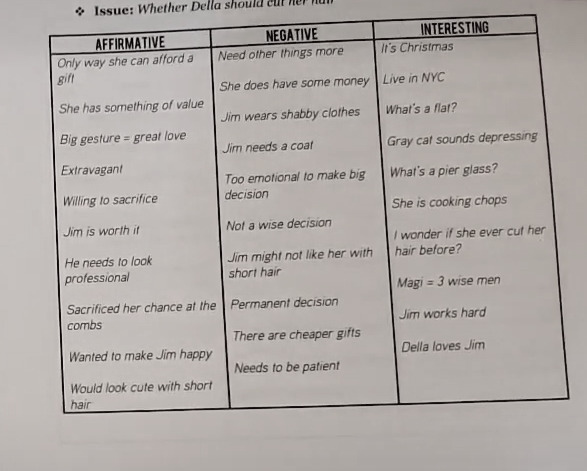
They then bring their completed ANI chart (as well as any other worksheets that the lesson may have assigned) back to the parent, who then corrects any errors and provides further guidance and review if necessary.
The second week’s lesson, which centers around Arrangement, is intended to help students organize their thoughts and arguments into some kind of structure.
In the case of a persuasive essay, through dialogue and modeling from text students learn to hone their thoughts and ideas into a general introduction, thesis, enumeration, exposition and conclusion that can then be refined into a formal outline.
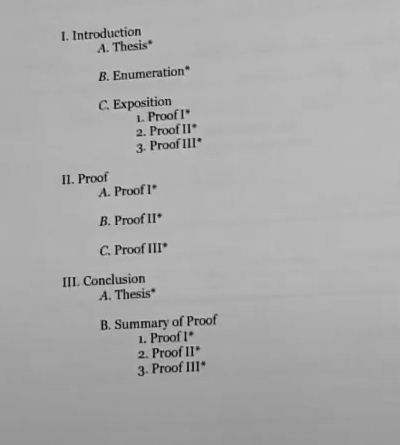
Once secure in these skills, as an assignment, students will generally use worksheets and templates in their to turn the ideas in their ANI chart into a workable outline, which they bring back for assessment.
The final week’s lesson concerns elocution and is where pencil hits paper.
During the instructional component, students learn various writing techniques, tools and tropes, such as metaphors, alliteration, personification, antithesis, compound sentences and more, which they can then use to flesh out their outline and, with the help of materials in their student workbook, create a rough draft.
Students can then, of course, make use of self-editing techniques, discussions and checklists to further refine their work until they’ve created a final draft.
As can be seen from the above, Lost Tools Of Writing can be very much an interactive, back and forth process between parents and students.
Parents and students work together to explore and review concepts, learn new skills, draw out and identify ideas, generate a plan of action, learn to use certain charts and so on.
Students go off and use the worksheets and toolsets in their workbooks to complete a step in the writing process and return for assessment before moving onto the next canon of writing.
Interestingly, throughout the process parents really act as facilitators as much as instructors, helping to draw out ideas through discussions and generally help students understand (through explanation, modeling and even demonstration) and practice key skills until the student is ready to try things out on their own in their student workbooks.
Further, the structured and incremental nature of the lessons, although seemingly slow at times, allows students to reliably and repeatedly generate rather impressively organized writing in a couple weeks and is a process that, with some practice, they should be able to eventually do on their own.
How Easy Is The Program To Teach With?
Initially, and particularly for parents new to the classical education model, Lost Tools Of Writing can require a bit of prep work before lessons, as parents will likely have to spend some time getting familiar with lesson objectives, watching the video lessons, going over the skills and concepts involved and generally being ready to lead discussions.
That said, while it’s perhaps not the most open and go program out there, it is a process that parents can get used to pretty quickly.
The teacher’s guides and videos lay things out quite clearly and simply, providing enough scripting to make lessons fairly easy to understand and conduct.
Further, the lessons being centered around the three canons of writing do make things a bit more familiar and easy to go through after a while, even if the specifics of what is being worked on and taught can change from lesson to lesson.
More than that, both the teacher’s guide and student workbooks provide a wide variety of rather intuitive checklists, charts and worksheets that can be really helpful in helping parents and students successfully ideate, organize, expand and refine the work.
Is The Lost Tools of Writing A Secular Curriculum?
The Lost Tools of Writing does, at times, make references to God and may provide examples from the Bible and/or Scripture and so isn’t a totally secular writing curriculum.
That said, the focus of the program is really focused on helping students hone their classical writing and thinking skills and the practical aspects of writing, which we feel it does quite well.
Thus, while perhaps not ideal for strongly secular homeschools, we feel it can be a good resource for most homeschools, especially if they are willing to substitute a few examples here and there to suit their preferences.
Pros and Cons
Pros
Video-based writing instruction
In addition to its teacher’s guides, Lost Tools Of Writing also offers parents access to short recorded videos that do a great job at explaining the course’s approach.
The videos outline lessons, demonstrate concepts visually, offer tips for teaching and generally help parents become familiar with the tools and skills being taught or used in each lesson.
These videos can make understanding and teaching rhetoric to students a lot easier for parents, particularly for those who are less familiar with a classical approach and those who are a bit rusty on their own writing skill.
Structured, systematic approach to writing
The Lost Tools of Writing teaches writing as a structured process, using a systematic approach and various tools to help students brainstorm, outline their thinking and ultimately create a piece of writing.
This approach can help students learn to approach a prompt in a more organized, step-by-step manner, which can really help students produce logical and well-thought and written essays and compositions .
It can also help demystify the process of writing and give students a tried and true set of tools to fall back on when faced with a prompt, something that can really benefit reluctant or fearful writers.
Incremental writing instruction
Over the course of its lessons and levels, Lost Tools of Writing helps students gradually build on the skills they learn and gradually helps them produce increasingly complex writing samples.
By not flooding students with mechanics, tools and tropes all at once, it can make the process of learning how to write a lot less intimidating and far more approachable for students.
Lots of opportunity for interesting discussions between parent and child
Lost Tools of Writing’s lessons often use a good deal of discussion and Socratic back-and-forth to help students at practically all stages of the learning process.
Whether they are coming up with an issue (or conclusion), working to understand or review certain concepts, or drawing out and organizing ideas from a text, there is a lot of good interaction between parent and student in Lost Of Writing that can help get kids engaged in the process and can give parents significant and valuable insight into their student’s thinking.
Charts and tools are intuitive, can help students organize ideas a lot easier
From its ANI charts to outline templates and short answer worksheets, Lost Tools of Writing provides students and parents with a lot of high quality tools and charts that they can use to simplify and organize the entire writing process, from ideation to editing.
Teacher’s guides are well thought out, easy to use
Although the concept of classical rhetoric can take some time for certain parents to get used to, Lost Tools of Writing’s teaching guide’s can make the process a lot easier.
They are well organized, well written and provide enough detail and scripting to make teaching fairly straightforward while still providing parents with enough flexibility to adapt lessons to their needs and students.
Really gets students engaged with the writing process
Through the use of interactive dialogues and discussions, students are often given significant freedom to generate their own thesis statements, generate their own ideas and points and so on.
This can make the process more personal and meaningful for them, which in turn can help them become more interested, engaged and even enthusiastic writers.
Cons
May require some prep work from parents
Before conducting lessons, parents may need to review the program’s videos and go through a week’s lessons, familiarizing themselves with the content and skills that will be presented and generally getting a good idea of dialogue flow.
Although not all that difficult or intensive, it does mean that the program isn’t quite open and go.
Can move a bit slowly and methodically for some students
The incremental introduction of skills and writing tools in the program can be a double-edged sword.
While it can ensure that students are solid on certain concepts and skills before moving on, and while it doesn’t flood students with information, some may feel that it progresses a bit too slowly at times and may become impatient with the desire to express themselves.
Who Is Lost Tools Of Writing Ideal For?
Homeschools looking for a writing program that emphasizes structure and organization
Lost Tools of Writing can be highly effective at getting students to view writing as an organized process.
It approaches writing using a sequential approach rooted in the canons of writing and spends a good deal of time helping students organize and lay out their thinking (using a wide assortment of tools and charts) before actually starting writing.
Those looking for a program that stresses logical thinking
While Lost Tools of Writing does help develop and refine a students ability to write, it also can help students learn to analyze an issue, organizing and thinking through their arguments in order to craft logical and persuasive points.
In this way, Lost Tools of Writing can be considered as much a logical thinking program as a writing program.
Fans of classical education and rhetoric
Lost Tools of Writing is firmly based on the tenets of classical rhetoric and therefore can be a natural fit for those who follow a classical educational framework.
Reluctant writers and those intimidated by the writing process
By demystifying the writing process and giving students a step-by-step framework to fall back on, Lost Tools of Writing can be a highly effective program for reluctant writers, those who blank out or stress out when prompted to write and those who are prone to chaotic writing habits.
Who Is It Not Ideal For?
Homeschools looking for a fast, open and go writing program
Although ultimately not that hard to teach with, Lost Tools of Writing does require parents to get up to speed before lessons with its videos and teacher’s guides, which means it’s not exactly a program that they can simply pick up and start teaching with on the day of.
Homeschools who prefer a more free-wheeling approach to writing
Lost Tools of Writing does approach writing as an organized and structured process and may not be an ideal fit for those who prefer students to develop their writing skills more naturally or who prefer to rely on the use of free-writing exercises.
Price
Note: Prices correct as of writing, all prices in USD.
As mentioned, Lost Tools of Writing does have a few components to it as a writing program.
It is divided into three levels (with an additional half course for comparison essays), and each level contains videos, workbooks and a teacher’s guide.
Level 1
Student Workbook: $39
Teacher’s guide: $79
Video subscription: $45
Complete Set: $147
Level 2
Student Workbook: $39
Teacher’s guide: $79
Video subscription: $27
Level 3
Student Workbook: $47
Teacher’s guide: $67
Video subscription: $27
Comparison Essays Semester Course
Teacher/Student Workbook All-In-One – $37
Videos: $27
Complete Set: $47
As always parents should check for the latest price for the course, as well as for any discounts or offers that may be available.
Or
Is It Worth The Price?
Overall, we feel that Lost Tools of Writing can provide a lot of value to homeschooling families.
It teaches writing in a very structured and organized manner, ultimately teaching students to create often quite impressive written work through a logical and sequential process.
It also keeps the learning process very manageable and approachable, slowly introducing new skills and allowing students to master them in their writing before introducing new ones and working on more complex pieces.
Further, the program offers parents quite a few teaching resources that they can use to make the process of teaching a lot easier, such as its straightforward, moderately scripted and well laid-out teaching guides and short, but effective, instructional videos.
At the same time, Lost Tools of Writing does offer a good deal of flexibility that allows students to feel more involved and engaged in the writing and that can allow parents to align the program with their own homeschool philosophies and preferences.
Bottom Line
With its straightforward and detailed teaching resources, helpful tools and charts, incremental approach to writing, and a strong foundation in classical education, Lost Tools of Writing can be an excellent resource for homeschools that can provide students with a reliable framework for producing high quality, persuasive and logical writing.

About the Author
Anne Miller is the editor of The Smarter Learning Guide and is a passionate advocate for education and educational technology. A mom of two, she majored in English Language and Literature and worked as a substitute teacher and tutor for several years. When not writing she continues to root for the Yankees and the Giants.
